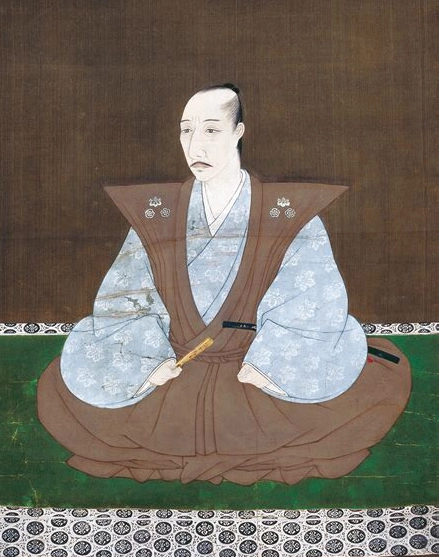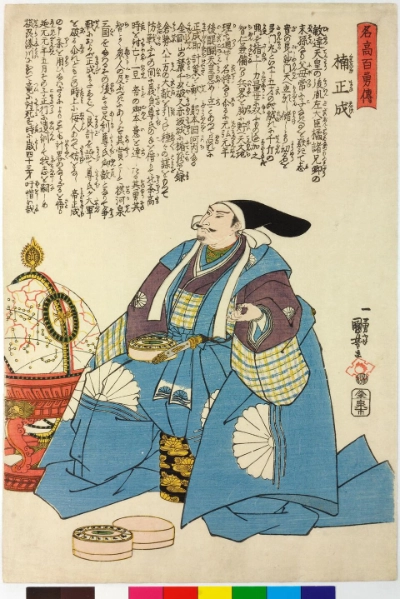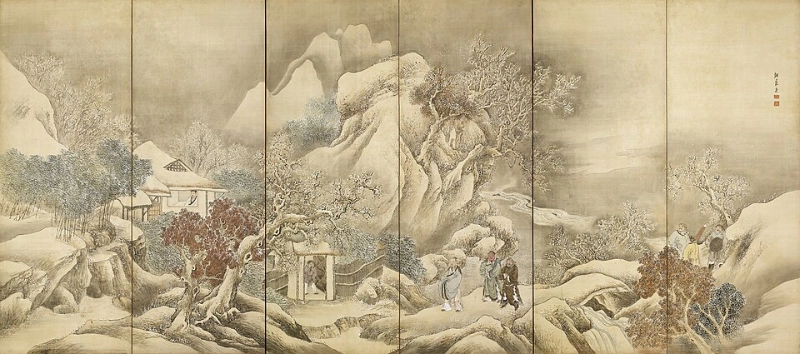Rhapsody for a forgotten flute, the life of Omori Sokun
I’m back, and if you’re wondering what odd treasure the mad flute hermit has hauled out of their bundle this time, you’d be right to ask!
Today, I bring you a story.
Or rather the tale of a life: the life of a master whose voice still echoes in the notes of a nearly-forgotten instrument : the hitoyogiri.
“A…what? But aren’t you all about the shakuhachi?”
Oh, I am. But I also play the hitoyogiri - the ancestor of the Fuke shakuhachi. In fact, before the Fuke shakuhachi adopted the name for itself, the instrument we now call hitoyogiri was widely known simply as “shakuhachi.”
I can already see a few puzzled faces out there.
Don’t worry, we’ll clear that up soon.
Come along!
Chasing Sokun
Maybe it all began with the name : Omori Sokun, appearing again and again in my hitoyogiri lesson book. From playing the music of his school to reading his words, I started to picture the hand that, four hundred years ago, shaped the characters I now try to animate with breath.
Truth be told, I suspect Ōmori Sōkun might be lingering at the edge of worlds - ear attuned, alert to the faintest trace of interest for his beloved flute.
Or perhaps he’s searching someone -anyone- curious enough to wonder who he was—beyond the manuscripts he spent so many years writing.
If so, maybe parts of me felt that tremor in the fabric of reality.
Something stirred.
A space opened -just wide enough for a ghostly suggestion to seep in.
Despite the 400 years that separate us, I set myself the challenge of reaching back through time to make his acquaintance.
Lacking a machine to catapult me into the 16th century, I gathered the information I had from class, then set off digging (thank you, Internet, labyrinth of knowledge) to piece together the story of his life. At the end of a long day hunched over my computer, I emerged from my den hungry, dehydrated… and triumphant—like an archaeologist waving a shard of pottery from a forgotten civilization.
A character was finally beginning to emerge from between the lines, and with him, the outline of a fascinating journey.
It took a few more days to put all that into… music -pun very much intended.
The computer overheated, my brain did too.
And here we are.
This article is a work in progress: I keep refining it as I find more information. My sources are listed at the bottom of this article, and you’ll see that they sometimes contradict one another (for instance, about how Sōkun’s ancestor may or may not have dispatched Masashige). In such cases, I prefer to let a bit of artistic blur remain rather than risk passing on misinformation. And when I mention “the sources,” I don’t mean that in some prophetic or all-knowing sense —after so much cross-checking and note-cutting, I honestly lost track of who said what. So everything’s down at the bottom, and if you feel like playing detective, you’re more than welcome to match each detail to its original author.
If, by any chance, you know more about the life of Ōmori Sōkun —if you spot an error in what I’ve written, or (dare I dream?) if you happen to own a secret manuscript detailing the finer points of his daily life— I’d be delighted to correct any slip-ups that found their way in. And absolutely ecstatic to learn more about this figure I’ve spent so many hours trying to bring back to life.
Ready? Let’s go.
Buckle up—we’re taking off.
Destination: Japan.
But not the Japan of travel brochures.
We’re heading to 1582. The Sengoku period is in full swing, and it can be summed up in two words: feudal chaos.
Nobunaga, the daimyō (warlord) of the Oda clan—nicknamed “the Demon King” for his ruthless military campaigns—has just died.
 Portrait of Oda Nobunaga by Kanō Eitoku (狩野永徳), ca 1584. - Photographic reproduction of a hanging scroll at Daitokuji, Kyoto. - Source: Wikimedia Commons. Public Domain.
Portrait of Oda Nobunaga by Kanō Eitoku (狩野永徳), ca 1584. - Photographic reproduction of a hanging scroll at Daitokuji, Kyoto. - Source: Wikimedia Commons. Public Domain.
Without getting lost in the details, let’s just say he was more than a fearsome commander. Visionary strategist and shrewd businessman, his legacy runs deeper than it seems.
And his death didn’t just rattle the nation —it shifted the course of Ōmori Sōkun’s story, too.
But before we get to that, let’s rewind a little.
Kyōto, 1570.
We’re at the dawn of the 17th century. Japan is just beginning to emerge from the turmoil of civil war. Look closely. Amid the power struggles and feudal ambitions, a figure is starting to stand out.
Let’s get closer. There he is. Or rather—there’s the boy we’re looking for.
His name is Taira Shinkurō (平 新九郎), sometimes written Shinjurō. A samurai in the making. A mind tuned to tactics. A musician with a growing voice.
But he’s not yet the Ōmori Sōkun that history will remember.
Born on March 15, 1570, in Kyōto, into a modest family of warrior lineage, Shinkurō grew up in the shadow of a famous ancestor: Ōmori Hikoshichi. Legend has it that Hikoshichi once crossed blades with the legendary Kusunoki Masashige —a symbol of unwavering samurai loyalty. The weight of his bloodline hangs over Shinkuro like a distant drumbeat —felt more than heard— as the young flutist begins to find his path.
 Kusunoki Masashige (楠正成) - by Utagawa Kuniyoshi, 1843–44. Woodblock print (oban tate-e). British Museum (Accession no. 2008,3037.15307). Public domain.
Kusunoki Masashige (楠正成) - by Utagawa Kuniyoshi, 1843–44. Woodblock print (oban tate-e). British Museum (Accession no. 2008,3037.15307). Public domain.
While this historical stew bubbles away, Shinkurō —the future Sōkun— is already showing a remarkable gift for music. His instrument of choice is the hitoyogiri, which he studies under the guidance of several monks, most notably at the temple of Myōken-ji. At the same time, he receives a Zen Buddhist training from Tenshuku Sōgan, a Rinzai master, at another temple you can still visit today: Daitoku-ji.
In this way, Shinkurō builds a rich foundation: a rigorous musical education, a spiritual grounding in Zen, and the martial legacy of his samurai lineage, which would eventually turn rōnin (masterless warriors) after the Ōnin War.
A solid résumé for the era - one that gets him a place in the military. He enters the service of Oda Nobunaga, likely as a page or young vassal.
But the war drums beat the tempo of history, and in 1582, everything falls apart. The head of the Oda clan loses his life in the Incident at Honnō-ji.
Shinkurō is only twelve years old. Suddenly, he finds himself without a lord, without a job —and at a decisive crossroads.
Instead of pursuing a military or administrative career under another warlord, he chooses retreat. One source suggests that the young boy opted for a life of renunciation after hearing a Zen anecdote known in Japanese as Saikō-sui (西江水), literally “West River water.” I explore that theory more fully in a separate article.
One thing’s for sure: Shinkurō leaves secular life to embark on a hermit’s journey.
In the first iteration of this article, I assumed —based on the information I had gathered—that he had chosen a “classic” form of seclusion away from the hustle and bustle of the city: a hermitage in the hills around Kyoto.
But that couldn’t be further from the truth. Research into hermitic trends in medieval Japan has revealed a very different picture —one in which spiritual life and worldly engagement were not always mutually exclusive. A very inspiring one, at that.
From temple diaries and personal records that have survived, we can draw the following conclusions:
-
Between Hermit and Wandering Devotee (浪蕩): After Honnōji, Shinkuro is described as abandoning secular life (“省みて世事を捨て浪蕩し、寸暇を惜しんで尺八に沒頭し…”), implying a semi-itinerant or reclusive existence —at least for certain periods— during which he prioritized spiritual and musical practice over material or official duties.
-
A Kyoto Base: Most biographical traces place Sōkun in and around Kyoto’s temple districts throughout his life. His early training in temples suggests he maintained close ties to Zen-affiliated monastic communities.
-
Temple Patronage: Records in the Rokuon-nichiroku (鹿苑日録, Keiun-era diaries of Daitoku-ji) show Sōkun performing regularly at high-profile ritual banquets and celebrations. This indicates that he was well integrated into the ritual and cultural life of Kyoto, rather than living in isolation.
-
No Fixed Hermitage Mentioned: Although he distanced himself from worldly affairs, no extant source identifies a permanent hermitage (山居, sankyo). Instead, he seems to have alternated between Kyoto’s temple quarters —where he wrote manuscripts and taught— and periods that, to this day, remain lost in the mist of history.
In short: the young Taira Shinkurō rooted himself in Kyoto’s Zen-temple circles, but adopted a semi-wandering lifestyle after 1582, focusing exclusively on hitoyogiri. There is no definitive record of a remote hermitage; instead, he appears to have moved between monastic residences and daimyō patronage sites in the greater Kyoto area.
At this point, he adopts a new name: Shuan, meaning “Hermitage on the Mountain Peak.” Just in case there was any doubt about the nature of his endeavor. This would remain his artistic name until his death.
 Liu Bei Visits Zhuge Liang in His Hermitage Three Times (草廬三顧)** - Yosa Buson (与謝蕪村), ca. 1750–1784. Folding screen (two-panel byōbu). Nomura Art Museum, Kyoto. Source: Wikimedia Commons. Public Domain.
Liu Bei Visits Zhuge Liang in His Hermitage Three Times (草廬三顧)** - Yosa Buson (与謝蕪村), ca. 1750–1784. Folding screen (two-panel byōbu). Nomura Art Museum, Kyoto. Source: Wikimedia Commons. Public Domain.
During his excursions into bustling Kyōto, Sokun crosses paths with monks from every school —Shingon, Tendai, Nichiren… They talk, they meditate, they play music -trading thoughts on spirit and sound alike.
Music lies at the very heart of our hermit’s concerns. More precisely: the hitoyogiri, that small bamboo flute that has accompanied him since childhood.
Sokun devotes himself to it, body and soul. He copies old pieces by hand, adapts contemporary melodies, and tries to preserve everything…before it’s too late.
The problem? the flute that gives rhythm to his days has fallen out of favor in the city. Urban audiences now prefer a shiny new instrument fresh from the Fuke tradition, nowadays’“shakuhachi”.
And yet, for nearly three centuries, the hitoyogiri has been the instrument of choice for samurai and scholars alike. Its fall from grace is easy enough to explain: a limited range —an octave and a half at best— and a modest volume that struggles to stand out against the koto or shamisen played by the “guitar heroes” of the late 16th century.
By contrast, the Fuke-style shakuhachi arrives with a bang —boasting a whopping three scales, deeper tones, greater resonance, and a voice that suits the new age.
But Sokun isn’t giving up. He’s convinced the two instruments can coexist —and he intends to prove it.
By the age of twenty-two, Sōkun’s skill with the hitoyogiri is known throughout the region. His growing reputation opens the doors of literary salons and tea pavilions, where audiences savor his performances between poetry recitations and philosophical debates.
By his thirties, diary entries from Zen priests serving as temple stewards at Rokuon-in (Shōkoku-ji) record him playing the flute late into the night at gatherings that could best be described as banquets awash in sake—though whether he joined in the merrymaking or remained a sober virtuoso remains unclear.
Despite leading a relatively austere life, Sōkun appears perfectly at ease amid this swirl of intellectual and spiritual ferment. He forms close ties with state officials, high-ranking samurai—and even the governor of Kyōto. It is said he traveled on horseback in their company: a clear sign of his proximity to the elite of his time.
And, as every great ascent demands the proper decorum (this is Japan, after all), Sokun begins to refine his public identity. In his forties, he formally settles on Sokun: the “kun” (勲) in “Omori Sokun” is an honorary title indicating his service to the emperor - but we’ll get to that), while continuing to use Shuan for his artistic endeavors.
Join me for part 2 of this article
This story keeps unfolding.
Week by week, I find new threads, stumble across new sources, and revisit old ones with fresh eyes.
The research has grown so extensive, I had to split this article in two—otherwise, we’d be venturing into novella territory.
And yet, the journey is far from over.
Join me in part 2 to continue exploring the remarkable legacy of Ōmori Sokun.